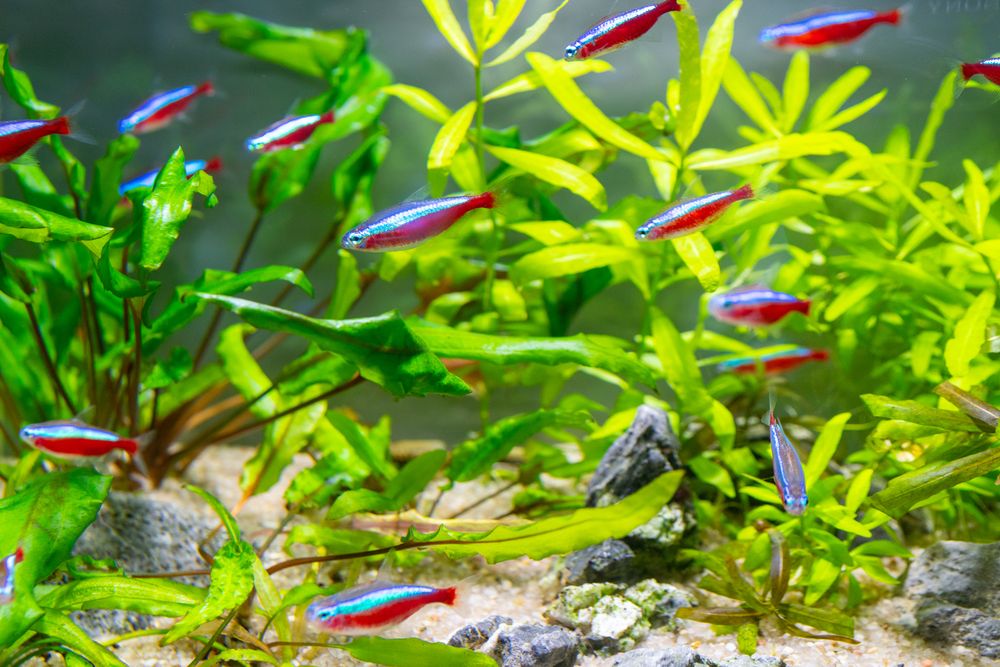Planted Nano Aquarium Setup - Beginner's Guide

Setting Up a Planted Nano Tropical Aquarium: A Beginner's Guide #
Setting up a planted nano tropical aquarium can be a fun and rewarding hobby. Whether you're a beginner or just looking to try something new, this guide will help you create a beautiful, thriving underwater ecosystem. Let’s dive in!
Step 1: Gather Your Supplies #
Before you start, make sure you have all the necessary supplies:
- Nano Aquarium Tank (5-10 gallons)
- Aquarium Stand or Sturdy Surface
- Aquarium Light (suitable for plant growth)
- Heater
- Filter
- Substrate (nutrient-rich for plants)
- Water Conditioner
- Plants
- Fish and Other Inhabitants
- Decorations (optional)
- Aquarium Test Kit
Step 2: Set Up the Tank #
- Choose a Location: Place your aquarium on a flat, sturdy surface away from direct sunlight to prevent algae growth and temperature fluctuations.
- Rinse the Tank: Clean the tank with water (no soap or chemicals) to remove any dust or debris.
Step 3: Add the Substrate #
- Rinse the Substrate: Thoroughly rinse the substrate to remove any dirt.
- Add the Substrate: Spread a 1-2 inch layer of substrate evenly on the bottom of the tank. A nutrient-rich substrate is essential for plant growth.
- Optionally, add decorative sand or gravel: Colour and type wil depend on your plants and what livestock (if any) you intend to keep. You also may want to have some areas unplanted, so some soil areas might be covered and others not. If in doubt, ask your local aquatic plant retailer for their recommendation on plant preferences.
Useful products #
- Tetra Complete Substrate: Excellent results with this, and great if you want a natural look without the potential mess of soil.
- Fluval Plant and Shrimp Stratum Aquarium Planting Substrate: Great if you intend on planting heavily. Alternatively you can bag it (see following link) and cover it with your decorative substrate of choice.
- Aquarium Media Zip Bag: Dark shade to blend with the aqua soil. Prevents the soil from mixing in with decorative gravel or sand but allows plants to penetrate into it and draw nutrients—the best of both worlds!
Step 4: Set Up Equipment #
- Install the Heater: Attach the heater to the side of the tank, near the bottom. Set it to a temperature between 75-80°F (24-27°C).
- Install the Filter: Place the filter in the tank according to the manufacturer’s instructions. Make sure it’s suitable for a nano aquarium.
- Install the Light: Position the light above the tank. Use an aquarium light designed for plant growth and set it to be on for 8-10 hours a day.
Top Tip: You might need to go for a heater rated slightly higher than the one recommended by the manufacturer, especially if the aquarium is not situated in a particularly warm room.
Step 5: Add Water #
- Condition the Water: Fill a bucket with tap water and add water conditioner to remove chlorine and other harmful chemicals.
- Fill the Tank: Slowly pour the conditioned water into the tank, filling it about halfway.
Step 6: Planting #
- Prepare the Plants: Trim any dead or damaged leaves and roots from your plants.
- Plant the Plants: Place root-feeding plants into the substrate, and attach plants like moss or ferns to rocks or driftwood. Ensure they are securely in place.
Step 7: Complete Filling the Tank #
- Fill the Tank: Slowly add more conditioned water until the tank is full.
- Start the Equipment: Plug in the heater and filter. Check that everything is working correctly.
Step 8: Cycling the Tank #
Before adding fish, you need to cycle the tank to establish beneficial bacteria that will help break down waste:
- Add Ammonia Source: You can use fish food or pure ammonia to start the cycling process.
- Test the Water: Use an aquarium test kit to monitor ammonia, nitrite, and nitrate levels.
- Wait: Cycling can take 4-6 weeks. Once ammonia and nitrite levels drop to zero and nitrate levels are low, the tank is cycled.
Step 9: Add Fish and Inhabitants #
- Choose Fish: Select small, compatible tropical fish suitable for a nano tank, such as neon tetras, guppies, or shrimp.
- Acclimate the Fish: Float the fish bag in the tank for 15-20 minutes to match the water temperature. Slowly add small amounts of tank water to the bag every 5 minutes for about 30 minutes.
- Release the Fish: Gently net the fish from the bag and release them into the tank.
Step 10: Maintenance #
- Regular Water Changes: Change 10-20% of the water weekly to keep the environment healthy.
- Monitor Water Parameters: Regularly test the water to ensure ammonia, nitrite, and nitrate levels are safe.
- Trim and Care for Plants: Trim dead leaves and prune plants to prevent overgrowth.
- Feed Fish: Feed your fish a balanced diet, but avoid overfeeding.
Congratulations! You’ve successfully set up a planted nano tropical aquarium. With regular care and maintenance, your mini underwater world will thrive and bring you joy for years to come.
